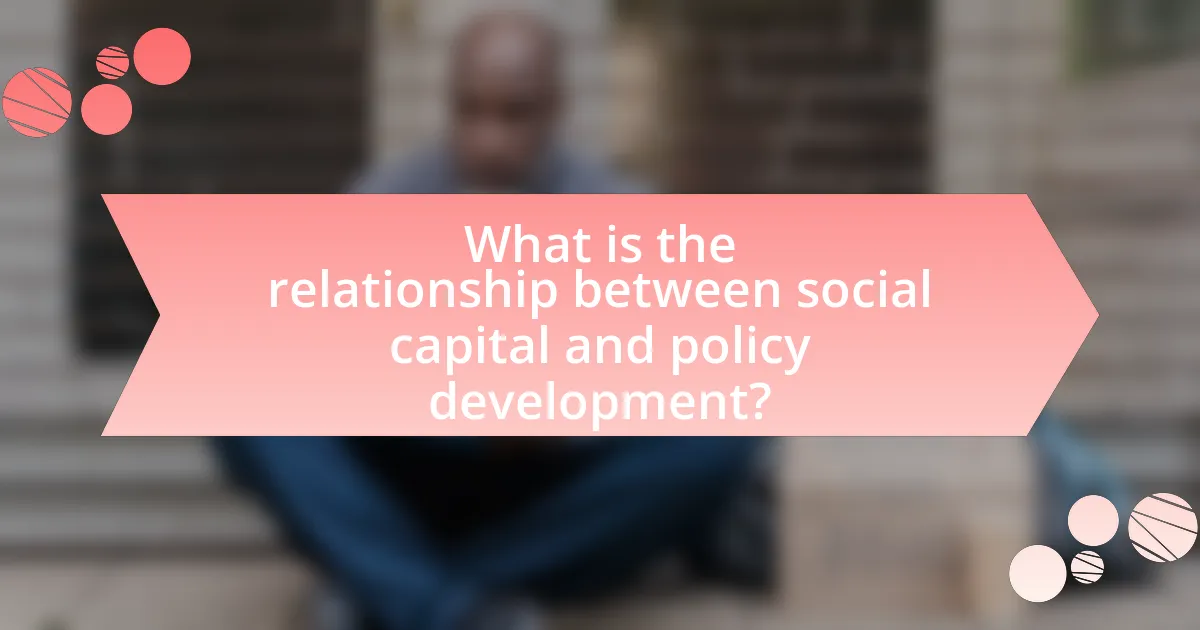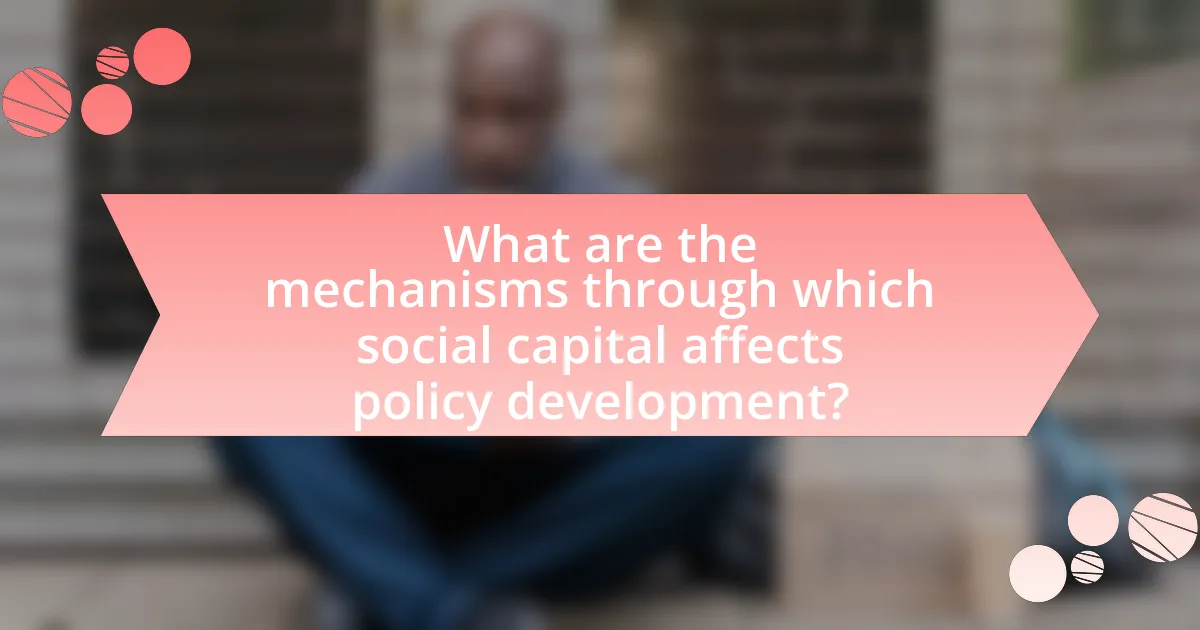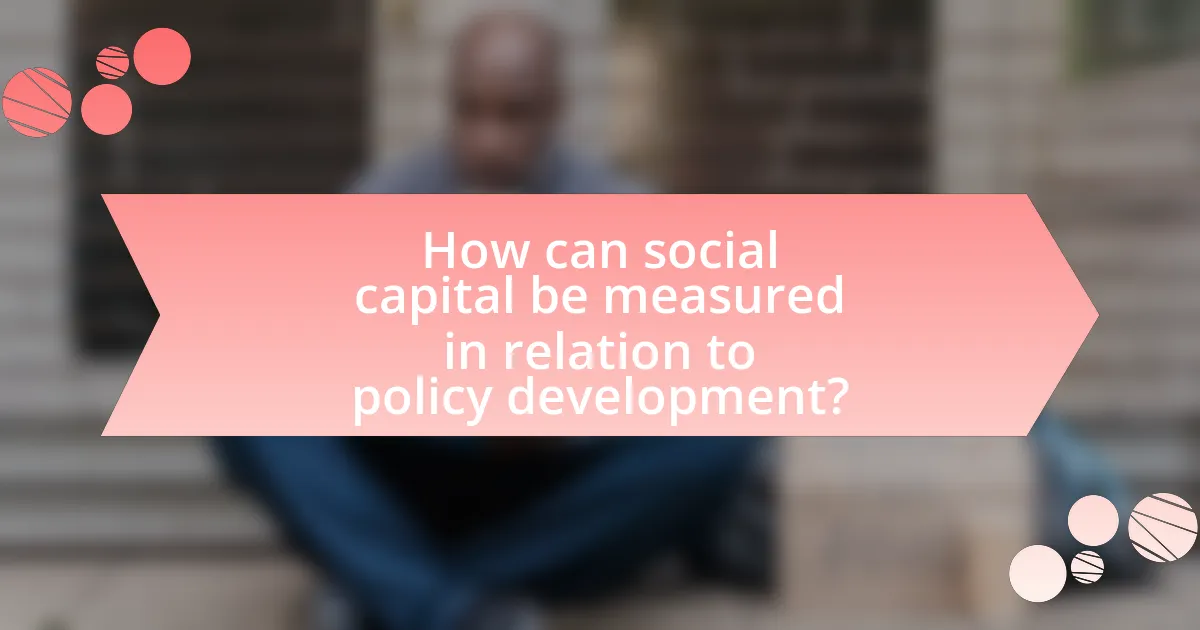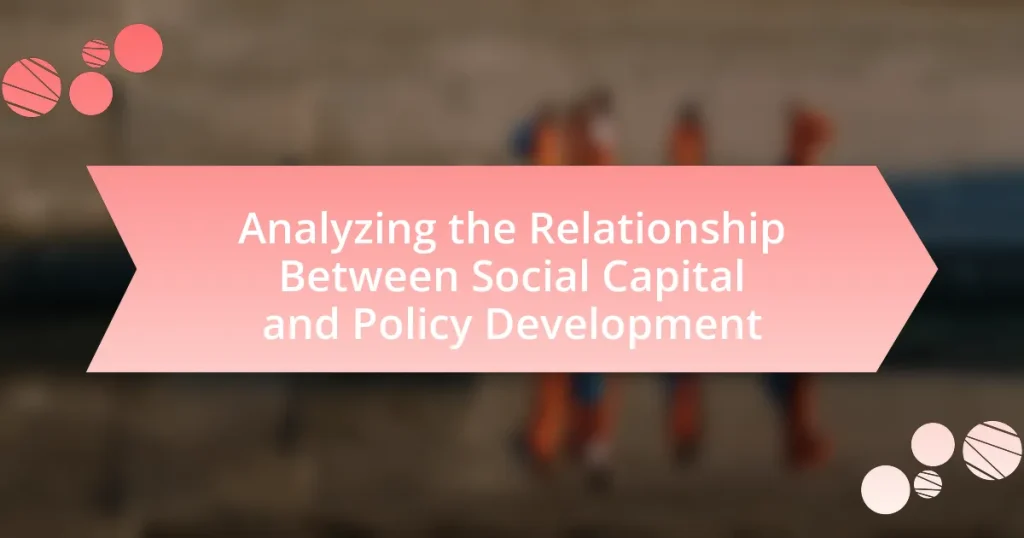The article analyzes the relationship between social capital and policy development, emphasizing how social capital fosters collaboration, trust, and networks among stakeholders, which are essential for effective policy formulation. It defines social capital in this context as the networks, relationships, and norms that facilitate collective action and cooperation. Key components such as trust, networks, and shared norms are discussed, highlighting their role in enhancing stakeholder engagement and policy effectiveness. The article also addresses the challenges of integrating social capital into policy development, the importance of measuring it, and strategies for leveraging social capital to improve policy outcomes.

What is the relationship between social capital and policy development?
Social capital significantly influences policy development by fostering collaboration, trust, and networks among stakeholders. High levels of social capital enable effective communication and cooperation, which are essential for identifying community needs and formulating responsive policies. Research indicates that communities with strong social ties are more likely to engage in participatory governance, leading to policies that reflect collective interests and enhance social cohesion. For instance, a study by Putnam (2000) in “Bowling Alone” demonstrates that communities with robust social networks tend to have better civic engagement and more effective local governance, illustrating the direct impact of social capital on policy outcomes.
How is social capital defined in the context of policy development?
Social capital in the context of policy development is defined as the networks, relationships, and norms that facilitate collective action and cooperation among individuals and groups. This concept emphasizes the importance of social interactions and trust in fostering effective governance and community engagement, which are critical for the successful implementation of policies. Research indicates that areas with high social capital often experience better policy outcomes due to increased civic participation and collaboration, as evidenced by studies showing that communities with strong social ties are more likely to mobilize resources and support for public initiatives.
What are the key components of social capital relevant to policy development?
The key components of social capital relevant to policy development are trust, networks, and norms. Trust facilitates cooperation among individuals and groups, which is essential for effective policy implementation. Networks, including social connections and relationships, enable the sharing of information and resources, enhancing collaborative efforts in policy-making. Norms, or shared values and expectations, guide behavior and foster a sense of community, which is crucial for mobilizing collective action in support of policies. These components collectively contribute to the effectiveness and sustainability of policy initiatives by promoting engagement and collaboration among stakeholders.
How does social capital influence stakeholder engagement in policy processes?
Social capital significantly enhances stakeholder engagement in policy processes by fostering trust, networks, and norms that facilitate collaboration. High levels of social capital enable stakeholders to communicate effectively, share information, and mobilize resources, which are crucial for participatory governance. For instance, research by Putnam (2000) in “Bowling Alone” illustrates that communities with strong social networks are more likely to engage in civic activities and influence policy outcomes. This correlation indicates that social capital not only encourages stakeholder participation but also leads to more effective and inclusive policy development.
Why is understanding this relationship important for policymakers?
Understanding the relationship between social capital and policy development is crucial for policymakers because it directly influences the effectiveness and sustainability of policies. Social capital, which encompasses the networks, norms, and trust that facilitate coordination and cooperation among individuals and groups, can enhance community engagement and compliance with policies. For instance, research indicates that communities with high social capital are more likely to participate in local governance and support initiatives, leading to better policy outcomes. This correlation is evidenced by studies showing that areas with strong social networks experience improved public health and economic resilience, highlighting the importance of integrating social capital considerations into policy formulation.
What role does social capital play in enhancing policy effectiveness?
Social capital significantly enhances policy effectiveness by fostering trust, collaboration, and communication among stakeholders. When communities possess strong social networks, they are more likely to engage in collective action, which leads to better implementation of policies. Research indicates that areas with high social capital experience improved governance outcomes, as citizens are more involved in decision-making processes and hold authorities accountable. For instance, a study by Putnam (1993) in “Bowling Alone” demonstrates that communities with robust social ties have higher levels of civic engagement, which correlates with more effective public policies.
How can social capital contribute to sustainable policy outcomes?
Social capital contributes to sustainable policy outcomes by fostering trust, collaboration, and collective action among community members. This enhanced social cohesion enables stakeholders to engage more effectively in the policymaking process, leading to policies that reflect the needs and values of the community. Research indicates that communities with high levels of social capital are more likely to implement successful environmental policies, as seen in the study by Pretty and Ward (2001), which found that social networks significantly influence local environmental governance. Additionally, social capital facilitates information sharing and resource mobilization, which are critical for the successful implementation of sustainable policies.

What are the mechanisms through which social capital affects policy development?
Social capital affects policy development through mechanisms such as enhanced communication, trust-building, and collective action. Enhanced communication among community members facilitates the sharing of information and ideas, which can lead to more informed policy decisions. Trust-building within social networks encourages collaboration among stakeholders, making it easier to reach consensus on policy issues. Collective action, driven by social capital, mobilizes community resources and efforts towards common goals, thereby influencing policy agendas and outcomes. Research indicates that communities with high social capital are more likely to engage in participatory governance, leading to policies that reflect the needs and preferences of the population, as evidenced by studies showing that social networks can significantly impact local policy initiatives.
How does social capital facilitate collaboration among stakeholders?
Social capital facilitates collaboration among stakeholders by fostering trust, networks, and shared norms that enhance communication and cooperation. When stakeholders possess strong social capital, they are more likely to engage in open dialogue, share resources, and work towards common goals, which is essential for effective collaboration. Research indicates that high levels of social capital lead to increased participation in collective decision-making processes, as seen in community development projects where stakeholders with established relationships are more willing to collaborate (Putnam, 2000). This interconnectedness not only streamlines the flow of information but also encourages a sense of accountability and mutual support, further strengthening collaborative efforts among diverse stakeholders.
What types of networks are most beneficial for policy development?
Collaborative networks are most beneficial for policy development. These networks facilitate the sharing of knowledge, resources, and expertise among diverse stakeholders, including government agencies, non-profit organizations, and community groups. Research indicates that collaborative networks enhance the effectiveness of policy-making by fostering innovation and ensuring that multiple perspectives are considered, which leads to more comprehensive and inclusive policies. For instance, a study by the National Academy of Sciences found that collaborative approaches in policy development resulted in higher satisfaction among stakeholders and improved implementation outcomes.
How does trust within communities impact policy implementation?
Trust within communities significantly enhances policy implementation by fostering cooperation and engagement among residents. When community members trust each other and their leaders, they are more likely to participate in policy discussions, support initiatives, and adhere to regulations. Research indicates that high levels of trust correlate with increased civic participation, which is essential for effective policy execution. For instance, a study by Putnam (1993) in “Bowling Alone” demonstrates that communities with strong social networks and trust experience better governance outcomes, as residents are more willing to collaborate and share resources. This collaborative spirit not only facilitates smoother implementation of policies but also leads to more tailored and effective solutions that reflect the community’s needs.
What challenges arise when integrating social capital into policy development?
Integrating social capital into policy development presents challenges such as measuring intangible assets, ensuring inclusivity, and balancing diverse stakeholder interests. Measuring social capital is difficult because it encompasses trust, networks, and norms that are not easily quantifiable, making it hard to assess its impact on policy outcomes. Ensuring inclusivity poses a challenge as policymakers must engage various community groups, which can lead to conflicts or power imbalances among stakeholders. Balancing diverse interests is also complex, as different groups may have conflicting priorities, complicating consensus-building efforts. These challenges highlight the need for careful consideration and strategic approaches in policy development that incorporates social capital effectively.
How can policymakers address the limitations of social capital?
Policymakers can address the limitations of social capital by implementing targeted community engagement initiatives that foster trust and collaboration among diverse groups. These initiatives can include programs that promote inclusivity, such as community-building activities and participatory decision-making processes, which have been shown to enhance social networks and strengthen community ties. Research indicates that areas with higher levels of social capital experience improved economic outcomes and social cohesion, as evidenced by the work of Putnam in “Bowling Alone,” which highlights the decline of social capital and its impact on civic engagement. By prioritizing policies that encourage social interaction and collective action, policymakers can effectively mitigate the limitations of social capital and promote a more interconnected society.
What are the risks of over-relying on social capital in policy frameworks?
Over-relying on social capital in policy frameworks can lead to several risks, including the potential for exclusion of marginalized groups. When policies are heavily influenced by existing social networks, those outside these networks may be overlooked, resulting in inequitable access to resources and opportunities. Additionally, excessive dependence on social capital can create a false sense of security, where policymakers assume that community ties will automatically lead to positive outcomes, neglecting the need for structural support and accountability. This can lead to ineffective policies that fail to address systemic issues, as evidenced by studies showing that communities with strong social ties but weak institutional frameworks often struggle to implement sustainable change.

How can social capital be measured in relation to policy development?
Social capital can be measured in relation to policy development through various quantitative and qualitative indicators, such as trust levels, network density, and civic engagement. Trust levels can be assessed using surveys that gauge public confidence in institutions and community members, while network density can be evaluated by mapping social connections within communities. Civic engagement can be measured by participation rates in local governance, volunteering, and community initiatives. Research indicates that higher levels of social capital correlate with more effective policy outcomes, as evidenced by studies showing that communities with strong social ties are better at mobilizing resources and implementing policies successfully. For instance, a study by Putnam in “Bowling Alone” highlights how social networks enhance collective action, which is crucial for effective policy development.
What indicators are used to assess social capital in policy contexts?
Indicators used to assess social capital in policy contexts include trust, social networks, civic engagement, and community participation. Trust is measured through surveys that gauge the level of confidence individuals have in their neighbors and institutions. Social networks are evaluated by analyzing the density and diversity of connections among community members. Civic engagement is assessed through participation rates in local governance and volunteer activities. Community participation is measured by the extent of involvement in community organizations and initiatives. These indicators provide a comprehensive understanding of social capital’s role in enhancing policy effectiveness and community resilience.
How do qualitative and quantitative methods differ in measuring social capital?
Qualitative and quantitative methods differ significantly in measuring social capital, primarily in their approach and data type. Qualitative methods focus on understanding the subjective experiences and social interactions that contribute to social capital, often using interviews, focus groups, and ethnographic studies to gather in-depth insights. For instance, qualitative research may reveal how trust and networks are built within a community, providing rich contextual data.
In contrast, quantitative methods emphasize numerical data and statistical analysis to measure social capital, often employing surveys and structured questionnaires to quantify aspects such as network size, participation rates, and levels of trust. For example, a quantitative study might use a Likert scale to assess community members’ trust in each other, allowing for statistical comparisons across different demographics.
The distinction lies in qualitative methods capturing the nuances and complexities of social relationships, while quantitative methods provide measurable and generalizable data. This difference is crucial for policymakers, as understanding both the qualitative and quantitative aspects of social capital can inform more effective policy development.
What are the best practices for evaluating the impact of social capital on policy outcomes?
The best practices for evaluating the impact of social capital on policy outcomes include employing mixed-method approaches, utilizing longitudinal studies, and incorporating quantitative metrics alongside qualitative assessments. Mixed-method approaches allow for a comprehensive understanding of social capital’s influence by combining statistical analysis with in-depth interviews or case studies, as evidenced by research conducted by Putnam in “Bowling Alone,” which highlights the correlation between social networks and civic engagement. Longitudinal studies track changes over time, providing insights into how social capital evolves and affects policy outcomes, as demonstrated in the work of Woolcock and Narayan, who emphasize the importance of temporal dynamics in social capital research. Additionally, using quantitative metrics, such as trust levels or community participation rates, alongside qualitative assessments ensures a robust evaluation framework, as shown in the World Bank’s “Social Capital: A Multifaceted Perspective,” which outlines various indicators for measuring social capital’s impact on development policies.
What strategies can enhance social capital for better policy development?
Strategies that can enhance social capital for better policy development include fostering community engagement, promoting collaborative networks, and investing in trust-building initiatives. Community engagement allows diverse stakeholders to participate in the policy-making process, ensuring that various perspectives are considered, which can lead to more effective policies. Collaborative networks, such as partnerships between government, non-profits, and private sectors, facilitate resource sharing and knowledge exchange, enhancing the collective capacity to address complex issues. Trust-building initiatives, such as transparency in decision-making and accountability measures, strengthen relationships among stakeholders, which is essential for sustained cooperation and effective policy implementation. Research indicates that regions with higher social capital tend to have more successful policy outcomes, as evidenced by studies showing that communities with strong social ties are better at mobilizing resources and responding to challenges.
How can community engagement initiatives strengthen social capital?
Community engagement initiatives strengthen social capital by fostering trust, collaboration, and shared values among community members. These initiatives create opportunities for individuals to connect, share resources, and work together towards common goals, which enhances social networks. Research indicates that communities with high levels of engagement exhibit stronger social cohesion and increased civic participation, leading to improved collective efficacy. For example, a study by Putnam in “Bowling Alone” highlights that communities with active civic engagement have higher levels of trust and cooperation, which are essential components of social capital.
What role do educational programs play in building social capital?
Educational programs play a crucial role in building social capital by fostering connections and networks among individuals and communities. These programs facilitate collaboration, enhance trust, and promote civic engagement, which are essential components of social capital. For instance, research by Putnam in “Bowling Alone” highlights that participation in educational initiatives increases social interactions and community involvement, leading to stronger social ties. Additionally, educational programs often encourage diverse participation, bridging gaps between different social groups, which further enhances the collective social capital within a community.
What are the practical implications of leveraging social capital in policy development?
Leveraging social capital in policy development enhances community engagement and improves policy outcomes. By utilizing networks of relationships and trust within communities, policymakers can gather diverse perspectives, leading to more inclusive and effective solutions. For instance, research by Putnam (2000) in “Bowling Alone” highlights that communities with strong social networks are more likely to participate in civic activities, resulting in policies that reflect the needs and values of the population. Additionally, social capital facilitates collaboration among stakeholders, which can streamline the implementation of policies and foster a sense of ownership among community members. This collaborative approach not only increases the likelihood of successful policy adoption but also builds resilience within communities, as evidenced by case studies in participatory governance.
How can policymakers effectively incorporate social capital into their strategies?
Policymakers can effectively incorporate social capital into their strategies by fostering community engagement and collaboration among stakeholders. This approach enhances trust and networks within communities, leading to more effective policy implementation. For instance, research by Putnam in “Bowling Alone” highlights that communities with strong social networks experience better governance and civic participation. By prioritizing initiatives that build relationships and encourage participation, such as public forums and collaborative projects, policymakers can leverage social capital to improve policy outcomes and community resilience.
What lessons can be learned from successful case studies of social capital in policy development?
Successful case studies of social capital in policy development demonstrate that community engagement and trust-building are essential for effective policy implementation. For instance, the case of the “Neighborhood Revitalization Initiative” in the United States showed that involving local residents in decision-making processes led to higher satisfaction and better outcomes in urban development projects. Research by Putnam (2000) in “Bowling Alone” highlights that communities with strong social networks are more likely to mobilize resources and collaborate effectively, resulting in policies that reflect the needs and values of the population. Additionally, the “Participatory Budgeting” model in Brazil illustrates how empowering citizens to influence budget allocations fosters transparency and accountability, ultimately enhancing public trust in government. These examples underscore the importance of leveraging social capital to create inclusive and responsive policy frameworks.
